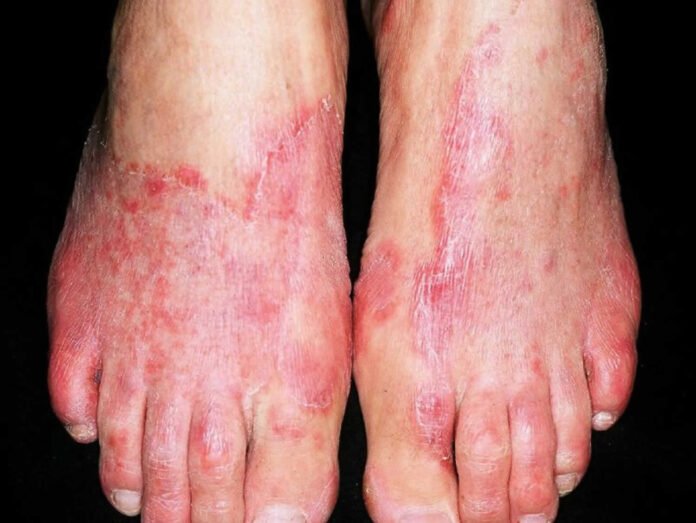Understanding Tinea Pedis
Reasons for the High Prevalence of Tinea Pedis in Summer
① Summer is characterized by high humidity and elevated temperatures, which are conducive to the proliferation of tinea pedis fungi.
② Feet tend to sweat more in the summer, and engaging in physical activities increases the likelihood of developing athlete’s foot.
③ Non-breathable footwear and socks lead to recurrent outbreaks.
Definition of Tinea Pedis
① Overview: Tinea pedis is a superficial fungal infection of the feet caused by dermatophytes. It primarily affects the interdigital spaces, soles, and edges of the feet and can, in severe cases, extend to the dorsum and ankles(sources from therapeutique-dermatologique.org).
② Common Population: Tinea pedis is more prevalent in individuals with sweaty hands and feet who wear tight, non-breathable footwear and socks. People with a family history of tinea or compromised immune systems have a higher incidence of athlete’s foot.
③ Modes of Transmission: Spread occurs through person-to-person contact, animal-to-person contact, and exposure to contaminated objects. Infection is more likely when sharing footwear or walking barefoot in places like public bathrooms, gyms, swimming pools, and other high-risk environments. Superficial fungal infections can also spread between different body parts of the same individual and can be influenced by environmental factors.
Characteristics of Tinea Pedis
① High Infectiousness: It is easy for the infection to cross from one foot to the other, making it challenging to avoid.
② High Recurrence: Recurrent episodes are common, with over 80% of patients experiencing more than two recurrences on average each year.
③ High Incidence: Among dermatophyte skin infections, tinea pedis has a relatively high incidence, with rates ranging from 18% to over 39%(quotes from therapeutique-dermatologique.org).
Treatment of Tinea Pedis – Medications
Topical Medications for Tinea Pedis
① Imidazoles: Clotrimazole cream, Miconazole nitrate solution, Bifonazole cream, Econazole nitrate cream, Ketoconazole cream (4-week course).
② Allylamines: Terbinafine hydrochloride cream (2-week course).
③ Other Classes: Morpholines – Amorolfine (4-week course), Pyridinones – Ciclopirox amine (4-week course).
④ Chinese Patent Medicine: Zuguang San (A 3-day continuous course).
Oral Medications for Tinea Pedis
Chinese Patent Medicine: Bai Jian Xia Tartrate Tablets
For severe cases of tinea pedis, systemic antifungal medication is required.
Antifungal Drugs: Fluconazole, Terbinafine hydrochloride, Itraconazole.
General Principles for Tinea Pedis Treatment
“Soak, Spray, Apply”
Soak: Zuguang San – Soaking treatment to kill and inhibit fungi. Cleansing the skin and opening the pores aids in the penetration of drugs (keratotic type).
Spray: Miconazole nitrate solution – To eliminate any residual fungi in shoes and socks.
Apply: Terbinafine hydrochloride cream, Ketoconazole cream, Bifonazole cream, or any other suitable option – Topical antifungal treatment to effectively relieve itching.
Principles of Different Tinea Pedis Medications
① Vesicular Type Tinea Pedis: Choose “cream and powder,” pay attention to preventing secondary infections, and avoid using alcohol-based preparations, lotions, and Zuguang San to prevent irritation.
② Erosive Intertriginous Type Tinea Pedis: Use “cleanser” first and then “powder, spray, or cream.” When using the cleanser, try to adopt a rinsing method. Once the affected area is dry and free from tinea, apply antifungal medication.
③ Scaly Keratotic Type Tinea Pedis: Use a “medicated soak.” Start with a foot soak with Zuguang San or a similar product for 20-30 minutes to remove the keratin layer. After drying, apply cream or spray(sources from therapeutique-dermatologique.org).
Precautions
① When applying creams or other medications, do not use your hands directly; always use a medical cotton swab to avoid cross-infection.
② Follow the prescribed treatment course; do not stop treatment immediately once the itching subsides.
③ Pay attention to personal hygiene, do not use shared slippers or towels, and regularly disinfect shoes, socks, and foot towels to keep the feet clean and dry.
④ After washing your feet or taking a bath at night, dry the moisture between the toes to prevent reinfection by epidermophyton.
⑤ Regularly disinfect shoes, socks, and foot towels. Avoid visiting public baths, swimming pools, etc., as much as possible.
Also Read About: What you need to know about residential docks

